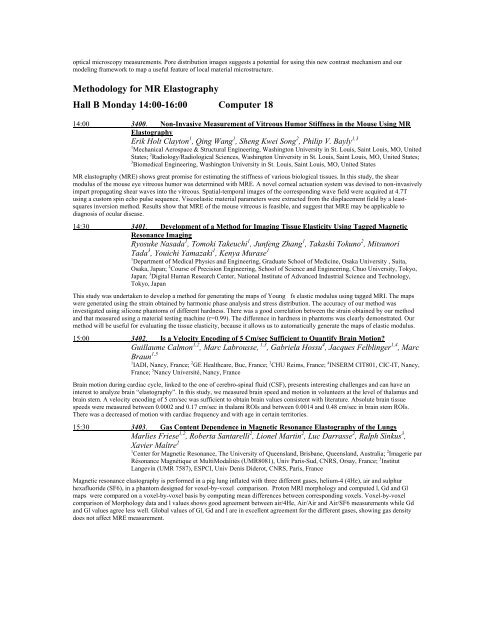ELECTRONIC POSTER - ismrm
ELECTRONIC POSTER - ismrm
ELECTRONIC POSTER - ismrm
Create successful ePaper yourself
Turn your PDF publications into a flip-book with our unique Google optimized e-Paper software.
optical microscopy measurements. Pore distribution images suggests a potential for using this new contrast mechanism and our<br />
modeling framework to map a useful feature of local material microstructure.<br />
Methodology for MR Elastography<br />
Hall B Monday 14:00-16:00 Computer 18<br />
14:00 3400. Non-Invasive Measurement of Vitreous Humor Stiffness in the Mouse Using MR<br />
Elastography<br />
Erik Holt Clayton 1 , Qing Wang 1 , Sheng Kwei Song 2 , Philip V. Bayly 1,3<br />
1 Mechanical Aerospace & Structural Engineering, Washington University in St. Louis, Saint Louis, MO, United<br />
States; 2 Radiology/Radiological Sciences, Washington University in St. Louis, Saint Louis, MO, United States;<br />
3 Biomedical Engineering, Washington University in St. Louis, Saint Louis, MO, United States<br />
MR elastography (MRE) shows great promise for estimating the stiffness of various biological tissues. In this study, the shear<br />
modulus of the mouse eye vitreous humor was determined with MRE. A novel corneal actuation system was devised to non-invasively<br />
impart propagating shear waves into the vitreous. Spatial-temporal images of the corresponding wave field were acquired at 4.7T<br />
using a custom spin echo pulse sequence. Viscoelastic material parameters were extracted from the displacement field by a leastsquares<br />
inversion method. Results show that MRE of the mouse vitreous is feasible, and suggest that MRE may be applicable to<br />
diagnosis of ocular disease.<br />
14:30 3401. Development of a Method for Imaging Tissue Elasticity Using Tagged Magnetic<br />
Resonance Imaging<br />
Ryosuke Nasada 1 , Tomoki Takeuchi 1 , Junfeng Zhang 1 , Takashi Tokuno 2 , Mitsunori<br />
Tada 3 , Youichi Yamazaki 1 , Kenya Murase 1<br />
1 Department of Medical Physics and Engineering, Graduate School of Medicine, Osaka University , Suita,<br />
Osaka, Japan; 2 Course of Precision Engineering, School of Science and Engineering, Chuo University, Tokyo,<br />
Japan; 3 Digital Human Research Center, National Institute of Advanced Industrial Science and Technology,<br />
Tokyo, Japan<br />
This study was undertaken to develop a method for generating the maps of Youngfs elastic modulus using tagged MRI. The maps<br />
were generated using the strain obtained by harmonic phase analysis and stress distribution. The accuracy of our method was<br />
investigated using silicone phantoms of different hardness. There was a good correlation between the strain obtained by our method<br />
and that measured using a material testing machine (r=0.99). The difference in hardness in phantoms was clearly demonstrated. Our<br />
method will be useful for evaluating the tissue elasticity, because it allows us to automatically generate the maps of elastic modulus.<br />
15:00 3402. Is a Velocity Encoding of 5 Cm/sec Sufficient to Quantify Brain Motion?<br />
Guillaume Calmon 1,2 , Marc Labrousse, 1,3 , Gabriela Hossu 4 , Jacques Felblinger 1,4 , Marc<br />
Braun 1,5<br />
1 IADI, Nancy, France; 2 GE Healthcare, Buc, France; 3 CHU Reims, France; 4 INSERM CIT801, CIC-IT, Nancy,<br />
France; 5 Nancy Université, Nancy, France<br />
Brain motion during cardiac cycle, linked to the one of cerebro-spinal fluid (CSF), presents interesting challenges and can have an<br />
interest to analyze brain “elastography”. In this study, we measured brain speed and motion in volunteers at the level of thalamus and<br />
brain stem. A velocity encoding of 5 cm/sec was sufficient to obtain brain values consistent with literature. Absolute brain tissue<br />
speeds were measured between 0.0002 and 0.17 cm/sec in thalami ROIs and between 0.0014 and 0.48 cm/sec in brain stem ROIs.<br />
There was a decreased of motion with cardiac frequency and with age in certain territories.<br />
15:30 3403. Gas Content Dependence in Magnetic Resonance Elastography of the Lungs<br />
Marlies Friese 1,2 , Roberta Santarelli 2 , Lionel Martin 2 , Luc Darrasse 2 , Ralph Sinkus 3 ,<br />
Xavier Maître 2<br />
1 Center for Magnetic Resonance, The University of Queensland, Brisbane, Queensland, Australia; 2 Imagerie par<br />
Résonance Magnétique et MultiModalités (UMR8081), Univ Paris-Sud, CNRS, Orsay, France; 3 Institut<br />
Langevin (UMR 7587), ESPCI, Univ Denis Diderot, CNRS, Paris, France<br />
Magnetic resonance elastography is performed in a pig lung inflated with three different gases, helium-4 (4He), air and sulphur<br />
hexafluoride (SF6), in a phantom designed for voxel-by-voxel comparison. Proton MRI morphology and computed l, Gd and Gl<br />
maps were compared on a voxel-by-voxel basis by computing mean differences between corresponding voxels. Voxel-by-voxel<br />
comparison of Morphology data and l values shows good agreement between air/4He, Air/Air and Air/SF6 measurements while Gd<br />
and Gl values agree less well. Global values of Gl, Gd and l are in excellent agreement for the different gases, showing gas density<br />
does not affect MRE measurement.
















